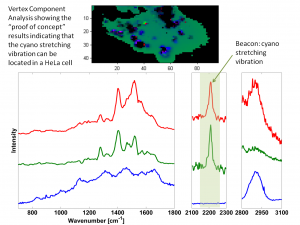Raman-active gold nanoparticles as beacons in breast cancer cells
Raman-active gold nanoparticles as beacons in breast cancer cells
Student: Jennifer Monahan
Department: Chemistry
Advisor: Max Diem
Abstract
Nanoparticles can be utilized to overcome the undesired side effects that occur with current chemotherapeutic treatments by delivering the drug directly to the tumor site. Raman-active gold nanoparticles (RA-AuNPs) can be used as biotags to deliver and track the nanosystem throughout cervical cancer cells by exploiting surface-enhanced Raman spectroscopic (SERS) effects. We propose a nanosystem design containing a gold nanosphere core along with a SERS reporter (2-cyano-2-hexanoic acid). This SERS reporter was chosen due to its cyano functional group, which can be used to track these particles. The location of the peak in the Raman spectrum is devoid of any other cellular information allowing for the use as a beacon. This inner core will be encapsulated by a hydrophobic pocket to allow for incorporation of hydrophobic drugs. The hydrophobic pocket will be surrounded by a hydrophillic outer layer, which will include targeting peptides for the HER2/neu receptor of breast cancer cells. The SERS reporter will behave as a beacon by enhancing the Raman signal while the targeting peptides will specifically target breast cancer cells. The use of Raman microspectroscopy allows for mapping of cancerous cells. When coupled with vertex component analysis contained in an in-house written MATLAB routine, namely ViChe, allows the production of pseudo color maps based on spectral dissimilarities. This process will allow us to detect and monitor RA-AuNPs capable of delivering chemotherapeutic agents.

